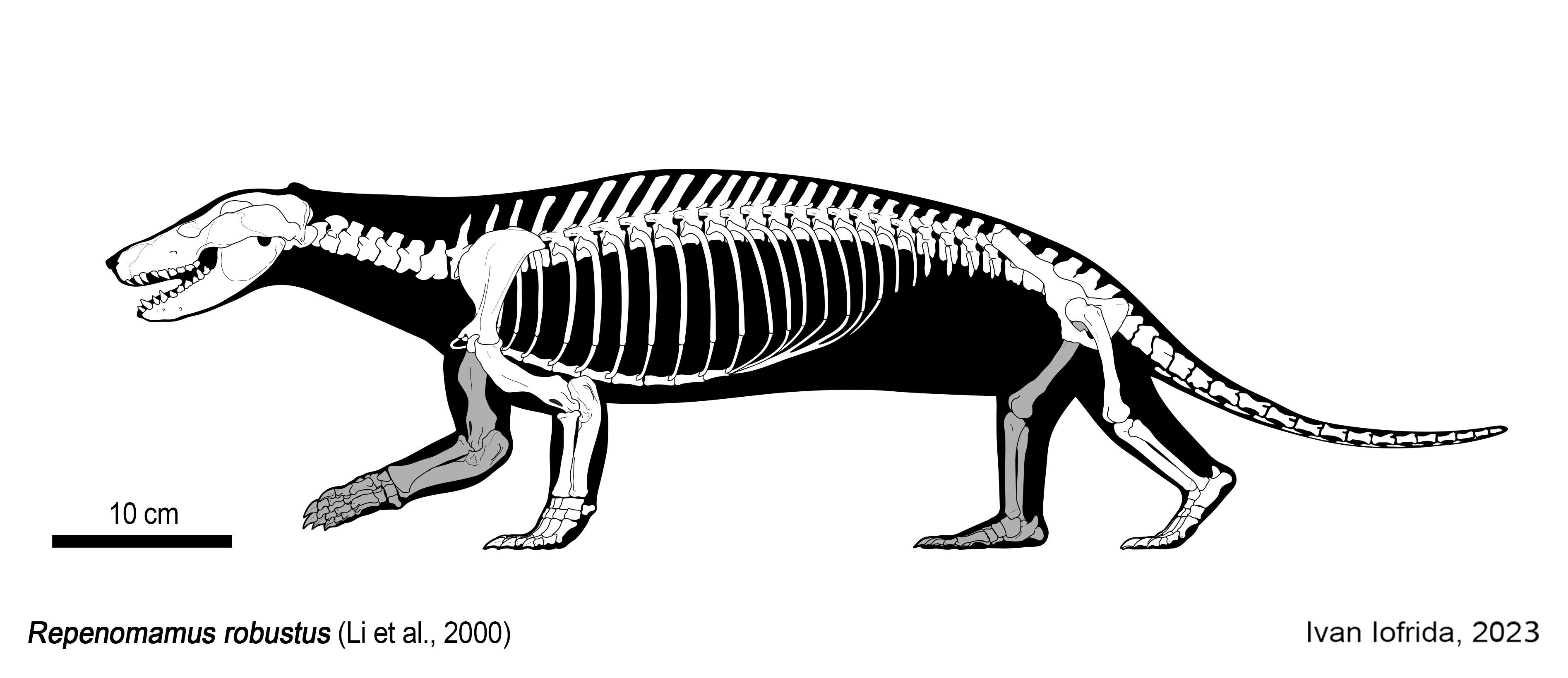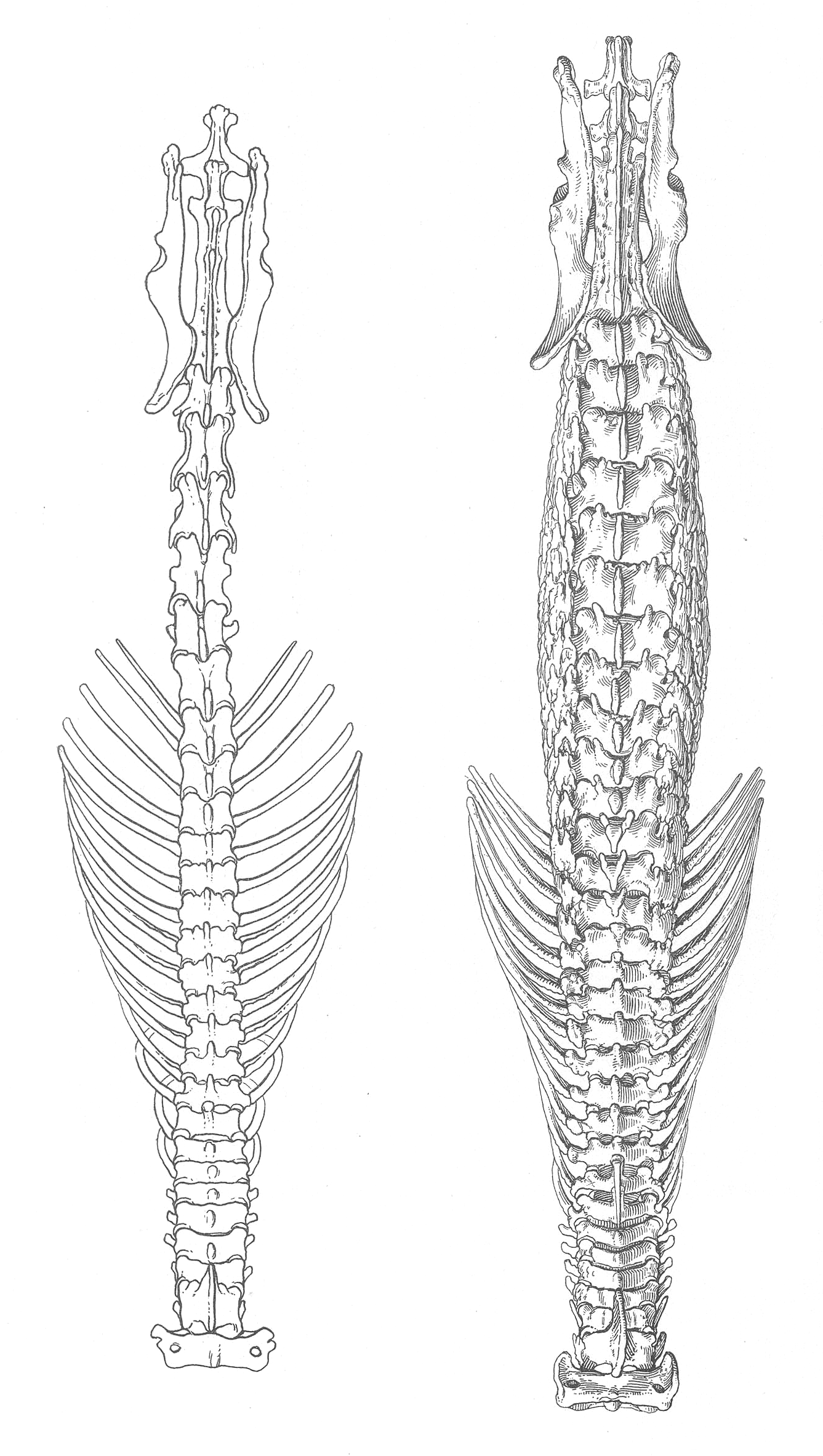|
Gobiconodontidae
Gobiconodontidae is a family of extinct mammals that ranged from the mid-Jurassic to the early Late Cretaceous, though most common during the Early Cretaceous. The Gobiconodontids form a diverse lineage of carnivorous non-therian mammals, and include some of the best preserved Mesozoic mammal specimens. Biology Like many other non-therian mammals, gobiocontids retained classical mammalian synapomorphies like epipubic bones (and likely the associated reproductive constrictions), venomous spurs and sprawling limbs. Through ''Spinolestes'' we also know that they had fur similar to that of modern mammals, with compound hair follicles with primary and secondary hairs. ''Spinolestes'' also possesses a clear diaphragm like modern mammals, as well as spines, dermal scutes and an ossified Meckel's cartilage. Furthermore, it may also display signs of dermatophytosis, suggesting that gobiconodontids, like modern mammals, were vulnerable to this type of fungal infection. Gobiconodontid de ... [...More Info...] [...Related Items...] OR: [Wikipedia] [Google] [Baidu] |
Gobiconodon
''Gobiconodon'' is an extinct genus of carnivorous mammals (or possibly non-mammalian mammaliaforms) belonging to the family Gobiconodontidae. Undisputed records of ''Gobiconodon'' are restricted to the Early Cretaceous of Asia and North America, but isolated teeth attributed to the genus have also been described from formations in England and Morocco dating as far back as the Middle Jurassic. Species of ''Gobiconodon'' varied considerably in size, with ''G. ostromi'', one of the larger species, being around the size of a modern Virginia opossum. Like other gobiconodontids, it possessed several speciations towards carnivory, such as shearing molariform teeth, large canine-like incisors and powerful jaw and forelimb musculature, indicating that it probably fed on vertebrate prey. Unusually among predatory mammals and other eutriconodonts, the lower canines were vestigial, with the first lower incisor pair having become massive and canine-like. Like the larger ''Repenomamus'' ther ... [...More Info...] [...Related Items...] OR: [Wikipedia] [Google] [Baidu] |
Repenomamus
''Repenomamus'' (Latin: "reptile" (reptilis), "mammal" (mammalis)) is a genus of opossum- to badger-sized Gobiconodontidae, gobiconodontid mammal containing two species, ''Repenomamus robustus'' and ''Repenomamus giganticus''. Both species are known from fossils found in China that date to the early Cretaceous period, about 125-123.2 million years ago. ''R. robustus'' is one of several Mesozoic mammals for which there is good evidence that it fed on vertebrates, including dinosaurs. Though it is not entirely clear whether these animals primarily hunted live dinosaurs or scavenged dead ones, evidence for the former is present in fossilized remains showcasing the results of what was most likely a predation attempt by ''R. robustus'' directed at a specimen of the dinosaur ''Psittacosaurus, Psittacosaurus lujiatunensis''. ''R. giganticus'' is among the largest mammals known from the Mesozoic era, only surpassed by ''Patagomaia''. Classification and discovery The fossils were rec ... [...More Info...] [...Related Items...] OR: [Wikipedia] [Google] [Baidu] |
Spinolestes
''Spinolestes'' is an extinct mammal genus from the Early Cretaceous of Spain. A gobiconodontid eutriconodont, it is notable for the remarkable degree of preservation, offering profound insights to the biology of non-therian mammals.Thomas Martin, Jesús Marugán-Lobón, Romain Vullo, Hugo Martín-Abad, Zhe-Xi Luo & Angela D. Buscalioni (2015). A Cretaceous eutriconodont and integument evolution in early mammals. Nature 526, 380–384. doi:10.1038/nature14905 Description ''Spinolestes holotype, MCCMLH30000A', hails from Las Hoyas, Spain. The living animal was about 24 centimeters long and weighted somewhere between 50 and 70 grams. As a Konservat-Lagerstätten specimen, it is famous for being remarkably well preserved, including not only the skeleton but also multiple soft tissues like fur, skin, internal organs and ears (both external and internal), a rarity among Mesozoic mammals. Besides soft-tissues, ''Spinolestes'' is also remarkable for its xenarthrous vertebrae, converge ... [...More Info...] [...Related Items...] OR: [Wikipedia] [Google] [Baidu] |
Fuxinoconodon
''Fuxinoconodon'' is an extinct genus of gobiconodontid that lived in China during the Early Cretaceous. It contains a single species A species () is often defined as the largest group of organisms in which any two individuals of the appropriate sexes or mating types can produce fertile offspring, typically by sexual reproduction. It is the basic unit of Taxonomy (biology), ..., ''F. changi''. References Cretaceous mammals of Asia Gobiconodontidae Prehistoric mammal genera {{Mammal-stub ... [...More Info...] [...Related Items...] OR: [Wikipedia] [Google] [Baidu] |
Xenarthrans
Xenarthra (; from Ancient Greek ξένος, xénos, "foreign, alien" + ἄρθρον, árthron, "joint") is a superorder and major clade of placental mammals native to the Americas. There are 31 living species: the anteaters, tree sloths, and armadillos. Extinct xenarthrans include the glyptodonts, pampatheres and ground sloths. Xenarthrans originated in South America during the late Paleocene about 60 million years ago. They evolved and diversified extensively in South America during the continent's long period of isolation in the early to mid Cenozoic Era. They spread to the Antilles by the early Miocene and, starting about 3 million years ago, spread to Central and North America as part of the Great American Interchange. Nearly all of the formerly abundant megafaunal xenarthrans became extinct at the end of the Pleistocene. Characteristics Xenarthrans share several characteristics that are not present in other placental mammals, which suggest that xenarthrans descend from ... [...More Info...] [...Related Items...] OR: [Wikipedia] [Google] [Baidu] |
Hero Shrew
The hero shrew (''Scutisorex somereni''), also known as the armored shrew, is a large shrew native to the Congo Basin of Africa. Its features are typical of a white-toothed shrew − short legs, slender snout, dense fur − except for a highly unusual spinal column. It has corrugated interlocking vertebrae that are unique among mammals except for its sister group, sister species, Thor's hero shrew. This unique adaptation allows the animal to bear a huge amount of weight on its back − according to an expedition team. The hero shrew lives in both lowland and mountain forests. They live in the undergrowth, feeding primarily on invertebrates. The evolutionary benefit of its unusual spine is unknown; it is hypothesized that it allows the animal to push itself under logs or between a palm tree's leaves and trunk to find food. Local tribes of people believe the hero shrew holds magical powers. It is classified as Least Concern by IUCN. Description Externally, the hero shrew res ... [...More Info...] [...Related Items...] OR: [Wikipedia] [Google] [Baidu] |
Anteaters
Anteaters are the four extant mammal species in the suborder Vermilingua (meaning "worm tongue"), commonly known for eating ants and termites. The individual species have other names in English and other languages. Together with sloths, they are within the order Pilosa. The name "anteater" is also commonly applied to the aardvark, numbat, echidnas, and pangolins, although they are not closely related to them. Extant species are the giant anteater ''Myrmecophaga tridactyla'', about long including the tail; the silky anteater ''Cyclopes didactylus'', about long; the southern tamandua or collared anteater ''Tamandua tetradactyla'', about long; and the northern tamandua ''Tamandua mexicana'' of similar dimensions. Etymology The name ''anteater'' refers to the species' diet, which consists mainly of ants and termites. Anteater has also been used as a common name for a number of animals that are not in Vermilingua, including the echidnas, numbat, pangolins, and aardvark. Anteate ... [...More Info...] [...Related Items...] OR: [Wikipedia] [Google] [Baidu] |
Nanocuris
''Nanocuris'' is an extinct genus of Deltatheridiidae from the Cretaceous of Canada (Saskatchewan) and United States (Wyoming - Lance Formation and Hell Creek Formation).R. C. Fox, C. S. Scott, and H. N. Bryant. 2007. A new, unusual therian mammal from the Upper Cretaceous of Saskatchewan, Canada. Cretaceous Research 28(5):821-829. Initially, it was classified in a proper family, Nanocuridae, in the clade Eutheria, but a reanalysis of a new specimen revealed a delthatheroid affinity of the genus. Size It was the largest deltatheroidean. Alongside with the similarly sized ''Altacreodus'', it likely replaced earlier Cretaceous eutriconodont Eutriconodonta is an order (biology), order of early mammals. Eutriconodonts existed in Asia (including Insular India, pre-contact India), Africa, Europe, North America, North and South America during the Jurassic and the Cretaceous periods. The ...s as a large sized predatory mammal. Classification Its closest relative is the smallest delt ... [...More Info...] [...Related Items...] OR: [Wikipedia] [Google] [Baidu] |
Scutes
A scute () or scutum (Latin: ''scutum''; plural: ''scuta'' "shield") is a bony external plate or scale overlaid with horn, as on the shell of a turtle, the skin of crocodilians, and the feet of birds. The term is also used to describe the anterior portion of the mesothorax in insects as well as some arachnids (e.g., the family Ixodidae, the scale ticks). Properties Scutes are similar to scales and serve the same function. Unlike the scales of lizards and snakes, which are formed from the epidermis, scutes are formed in the lower vascular layer of the skin and the epidermal element is only the top surface . Forming in the living dermis, the scutes produce a horny outer layer that is superficially similar to that of scales. Scutes will usually not overlap as snake scales (but see the pangolin). The outer keratin layer is shed piecemeal, and not in one continuous layer of skin as seen in snakes or lizards. The dermal base may contain bone and produce dermal armour. Scutes with a ... [...More Info...] [...Related Items...] OR: [Wikipedia] [Google] [Baidu] |
Deltatheroida
Deltatheroida is an extinct group of basal metatherians that were distantly related to modern marsupials. The majority of known members of the group lived in the Cretaceous; one species, '' Gurbanodelta kara'', is known from the late Paleocene ( Gashatan) of China. Their fossils are restricted to Central Asia and North America. This order can be defined as all metatherians closer to '' Deltatheridium'' than to Marsupialia. When they were first identified in the 1920s, they were believed to be placentals and possible ancestors of the " creodonts" (a polyphyletic group of extinct carnivorous mammals from the Paleogene and Miocene), but this was later disproven. Nonetheless, deltatheroideans do converge on hyaenodontids, oxyaenids, carnivorans, dasyuromorphs, thylacoleonids and sparassodonts in many details of their dental anatomy, suggesting a carnivorous lifestyle.CHRISTIAN DE MUIZON and BRIGITTE LANGE-BADRÉ, Carnivorous dental adaptations in tribosphenic mammals and phylo ... [...More Info...] [...Related Items...] OR: [Wikipedia] [Google] [Baidu] |
Cusp (anatomy)
A cusp is a pointed, projecting, or elevated feature. In animals, it is usually used to refer to raised points on the crowns of teeth. The concept is also used with regard to the leaflets of the four heart valves. The mitral valve, which has two cusps, is also known as the bicuspid valve, and the tricuspid valve has three cusps. In humans A cusp is an occlusal or incisal eminence on a tooth. Canine teeth, otherwise known as cuspids, each possess a single cusp, while premolars, otherwise known as bicuspids, possess two each. Molars normally possess either four or five cusps. In certain populations the maxillary molars, especially first molars, will possess a fifth cusp situated on the mesiolingual cusp known as the Cusp of Carabelli. One other variation of the upper first premolar is the 'Uto-Aztecan' upper premolar. It is a bulge on the buccal cusp that is only found in Native American Indians, with highest frequencies of occurrence in Arizona. The name is not a d ... [...More Info...] [...Related Items...] OR: [Wikipedia] [Google] [Baidu] |
Occlusion (dentistry)
Occlusion, in a dental context, means simply the contact between teeth. More technically, it is the relationship between the maxillary (upper) and mandibular (lower) teeth when they approach each other, as occurs during chewing or at rest. Static occlusion refers to contact between teeth when the jaw is closed and stationary, while dynamic occlusion refers to occlusal contacts made when the jaw is moving. The masticatory system also involves the periodontium, the TMJ (and other skeletal components) and the neuromusculature, therefore the tooth contacts should not be looked at in isolation, but in relation to the overall masticatory system. Anatomy of Masticatory System One cannot fully understand occlusion without an in depth understanding of the anatomy including that of the teeth, TMJ, musculature surrounding this and the skeletal components. The Dentition and Surrounding Structures The human dentition consists of 32 permanent teeth and these are distributed between ... [...More Info...] [...Related Items...] OR: [Wikipedia] [Google] [Baidu] |




